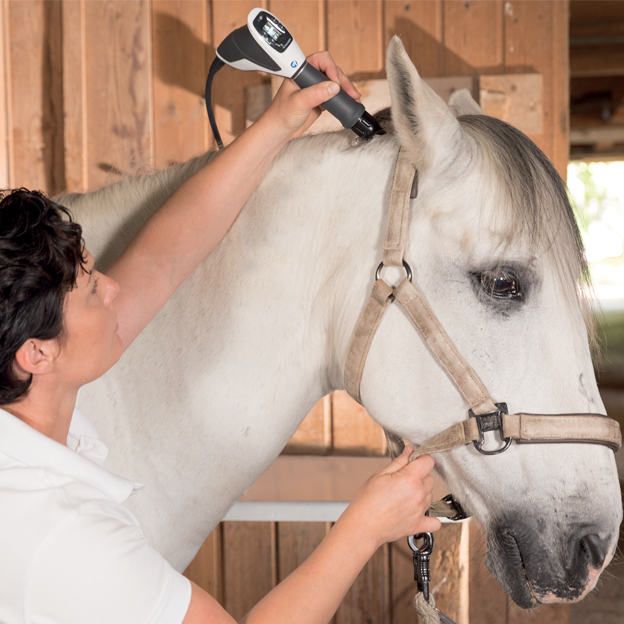Equine Therapy Success Stories: Actual Individuals, Genuine Emotional Improvements
Equine Therapy Success Stories: Actual Individuals, Genuine Emotional Improvements
Blog Article
How Laser Therapy in Horse Therapy Is Revolutionizing Veterinary Take Care Of Steeds
Laser treatment has actually arised as a transformative strategy in equine veterinary treatment, providing a non-invasive option that expedites recovery and boosts total health. The mobility and flexibility of laser therapy devices additionally highlight their expanding necessity among vets.
Recognizing Laser Treatment

The modern technology behind laser therapy is grounded in the concept of photochemistry, where photons are absorbed by chromophores within cells, resulting in boosted ATP manufacturing and inflection of reactive oxygen species (Equine Therapy). This, consequently, promotes mobile spreading, decreases inflammation, and speeds up healing. Veterinary specialists utilize various kinds of lasers, consisting of low-level lasers (LLLT) and high-power Course IV lasers, relying on the certain healing goals and the nature of the equine problem being dealt with
Various laser wavelengths and power setups are thoroughly chosen to target various tissue midsts and attain wanted professional end results. Safety and security procedures are vital, as incorrect usage can result in thermal damage or suboptimal therapeutic results. Thus, an extensive understanding of laser treatment's mechanisms and applications is essential for its effective execution in equine vet practice.
Advantages for Horse Health And Wellness
The myriad advantages of laser therapy for equine wellness include boosted healing, discomfort reduction, and boosted wheelchair. This advanced treatment modality leverages particular wavelengths of light to pass through tissues, stimulating mobile function and promoting quick tissue repair service. The non-invasive nature of laser therapy guarantees marginal anxiety and pain for the horse, assisting in a smoother recovery process.
Boosted recovery is among the leading advantages, as laser therapy speeds up mobile regeneration and collagen synthesis. This results in much faster healing times from injuries and procedures. Pain reduction is accomplished via the anti-inflammatory effects of laser therapy, which decreases swelling and minimizes the manufacturing of pain-inducing chemicals. As a result, horses experience considerable remedy for persistent and sharp pain problems.
By minimizing swelling and pain, and boosting cells repair service, laser treatment assists in restoring joint function and muscle adaptability. Hence, laser treatment stands as a transformative tool in modern horse veterinary treatment.
Common Conditions Dealt With
Laser therapy has become a flexible treatment alternative for a range of common equine problems. Among these, musculoskeletal injuries are specifically open to laser therapy. Equine Therapy. Soft tissue injuries, such as tendonitis and ligament strains, gain from the anti-inflammatory and analgesic impacts of laser treatments, which increase recovery and decrease pain. Additionally, laser treatment is efficient for problems like osteo arthritis, where it helps minimize joint swelling and promote cells repair work.
Wound administration is an additional area where laser therapy has shown substantial guarantee. Persistent injuries or slow-healing ulcers can be specifically challenging in equines, yet laser therapy boosts cellular regeneration and enhances blood flow, thus accelerating the healing process. In addition, laser treatments have been effectively employed in handling unguis conditions such as laminitis and abscesses, minimizing discomfort and advertising much faster healing.

Innovation Behind Laser Therapy
Beyond the myriad conditions treatable with laser treatment, the modern technology itself qualities better assessment. At the heart of laser therapy is making use of specific wavelengths of light to pass through cells and generate biological responses. These wavelengths, normally varying from 600 to 1000 nanometers, are precisely absorbed by chromophores in the skin, muscle, and various other tissues, instigating a waterfall of mobile occasions.
Laser gadgets used in vet medication typically utilize low-level laser treatment (LLLT) or chilly laser therapy. Unlike high-powered medical lasers, these gadgets operate at reduced energy levels, maximizing restorative benefits while minimizing thermal damages. The power from the laser light promotes adenosine triphosphate (ATP) production, boosts cellular metabolism, and increases tissue repair procedures.

Success Stories and Instance Researches

Showcasing the tangible benefits of laser therapy, various success stories and study brighten its transformative effect on equine wellness. One such case involves a pureblood racehorse struggling with persistent tendonitis. Standard therapies yielded minimal improvement, but after incorporating laser treatment right into the routine, the horse exhibited significant decreases in swelling and discomfort within weeks, eventually returning to competitive auto racing.
Another compelling instance includes a dressage equine identified with severe back pain, restricting its performance. A vet group used low-level laser treatment (LLLT) to target the irritated areas, resulting in significant renovation in versatility and a noteworthy reduction in discomfort. Over several sessions, the steed regained its peak kind, showcasing the effectiveness of laser therapy in addressing musculoskeletal concerns.
In addition, a research study conducted at a leading equine facility taken a look at 50 horses with numerous soft tissue injuries treated with laser therapy. The outcomes stood out: 85% of the horses showed sped up healing times and enhanced movement. These instances highlight the adaptability and efficiency of laser treatment in equine medicine, offering a non-invasive, scientifically-backed technique to enhancing recuperation and performance in equines.
Verdict
Laser treatment is revolutionizing equine vet care by supplying a non-invasive therapy that speeds up recovery, decreases click swelling, and minimizes discomfort. With its efficiency in dealing with a series of problems, from bone and joint injuries to chronic disorders like osteoarthritis, this technology dramatically enhances equine health and wellness and mobility. The mobility and flexibility of laser therapy even more emphasize its transformative effect on veterinary methods, strengthening its duty as a vital device in modern equine health care.
Report this page